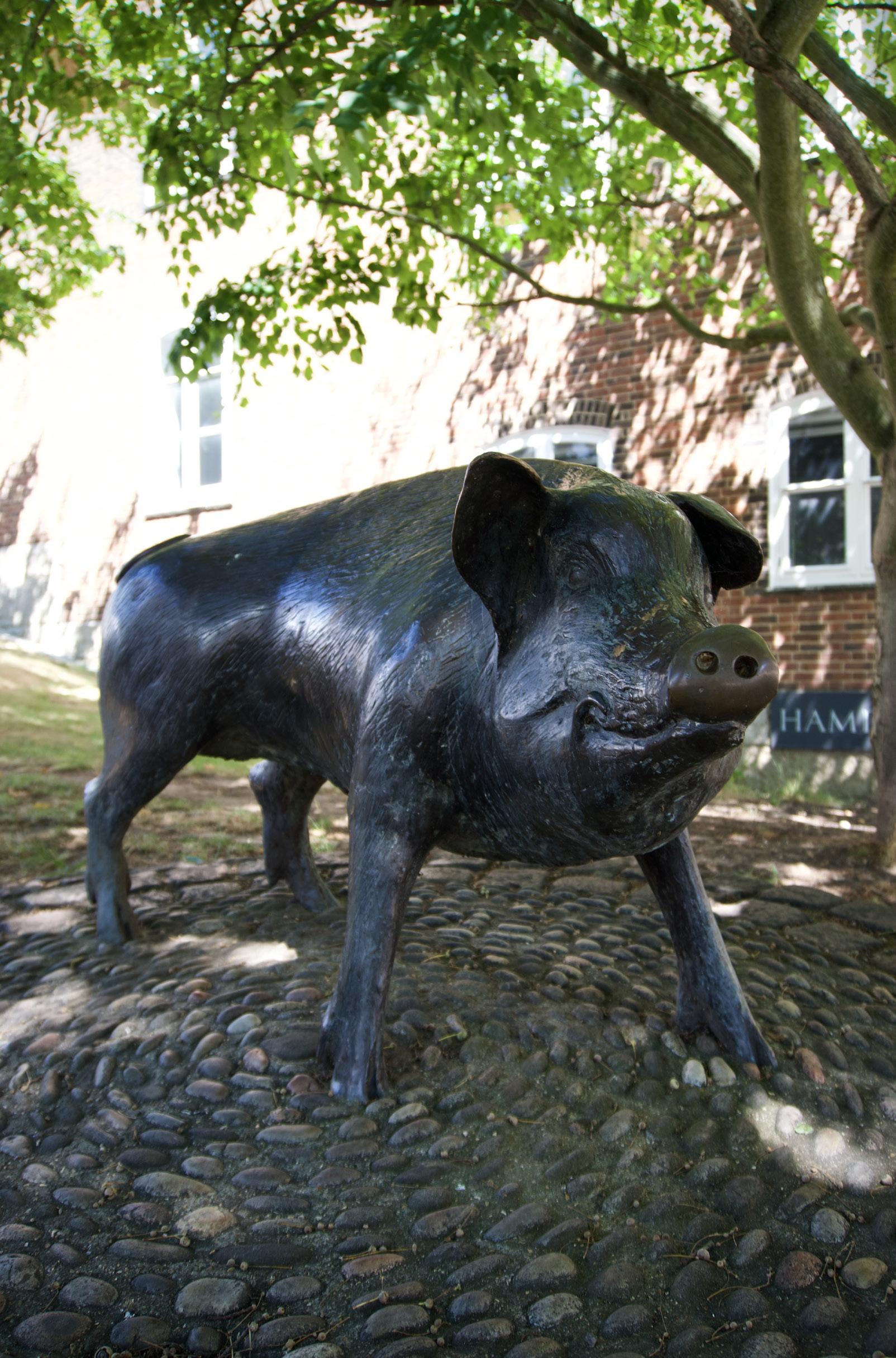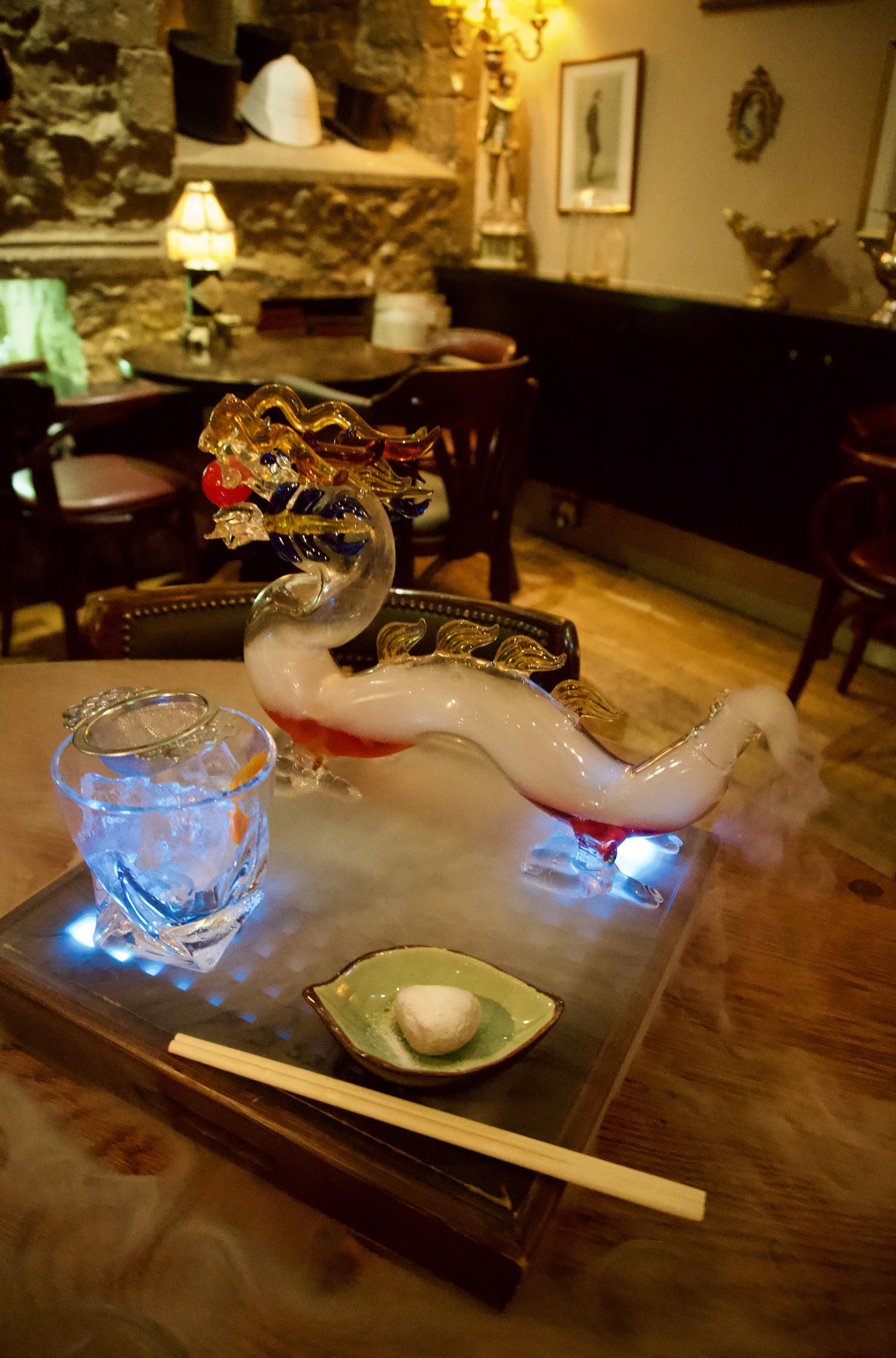

The Bollards
Making beauty out of the mundane
As you cross The Square, whether from the High Street towards the Cathedral or vice-versa, and look towards The Old Vine – her gaze keeps following you. Though she doesn’t move, her eyes track you wherever you stand, her mouth curled into a subtle smile – just as in the original.
Leonardo da Vinci’s famous painting The Mona Lisa isn’t only found behind protective glass in The Louvre: you can also see it on the curved surface of a Winchester bollard. And it is not the only masterpiece honoured in this public space: more than three dozen bollards have been adorned with works by renowned artists like Matisse, Magritte and Mondrian.
In 2005, the painters Jenny Muncaster and Rachael Alexander, who run The Colour Factory, set out to inject life and colour into Winchester’s then ‘drab and dreary’ street furniture. Initially, the city council granted them permission to paint five bollards – an initiative believed to be the first of its kind in the country – for the duration of the annual Hat Fair.
Painting with acrylic on an even surface is one thing but replicating complex artworks on the bent, textured surface of cast-iron bollards was entirely a different matter. Firstly, the weather needed to be right. ‘Even a small drop of rain would make the work impossible,’ Jenny says. Secondly, special paint that would not rust had to be used. Rachael adds: ‘The paint is great, but it dries already on the brush. Even if you stopped for a little chat, you would have to remix it.’
However, the bollards were so well received by residents that Jenny and Rachael did not just avoid repainting them in black and white after the fair – they went on to paint numerous others, advised various cities across the UK and compiled a Bollard Advice Manual. Some even claim that Winchester’s Mona Lisa bollard has now been photographed more often than the city’s Cathedral!


Address The Bollards, The Square, Winchester, SO23 9EX | Getting there
An 11-minute walk from Winchester railway station | Hours Accessible 24 hours | Tip The Old Vine, the 18th-century inn behind the Mona Lisa bollard, offers delicious food in a charming atmosphere.
Cheesefoot Head
Where Eisenhower rallied his troops
Be careful! The car park appears unexpectedly, just before the gentle peak on a racy uphill curve of the A272. Nevertheless, as you get out of your vehicle and make your way to the little gate at the bottom of the car park, you will immediately be charmed. Here, your gaze can travel far and wide: the flaxseed might gently sway in a breeze, and up in the air you may even witness the powerful dance between soaring buzzards.
Follow the little path that runs along the road until you come to another gate. If it is late spring or early summer, the air will smell citrusy fresh with elderflower, which grows in thick bunches along the South Downs path you have just entered. As you step towards the mesh fence on the other side of the trail, a wide, natural bowl opens below you.
This bowl was shaped by the melting water of glaciers, which eroded the soft chalk during the last Ice Age, approximately 110,000 years ago. However, this spot wasn’t just shaped by the past, it also helped shape history.
In the spring of 1944, British and American soldiers gathered in this very area to prepare for D-Day. One day, the banks filled with troops eager to witness champion Joe Louis demonstrating his skills. Later, on 6 June 1944, General Dwight D Eisenhower (then commander of the historic Operation Overlord and later the 34th President of the United States of America) shared a speech with 100,000 troops that he had been preparing for months. In it, he addressed ‘Soldiers, Sailors, and Airmen of the Allied Expeditionary Force’, warning them that they were ‘about to embark upon the great crusade’, but also inspiring optimism, by declaring that the ‘tide has turned’ and they would ‘accept nothing less than victory’.
A recorded version of the speech was played across southern England. It is now considered one of the most listened to and most recognisable speeches in the world.


Address Cheesefoot Head, A272, Winchester, SO24 0HU | Getting there An 8-minute drive from Winchester city centre; park at Cheesefoot Head car park | Hours Accessible 24 hours | Tip The voco Winchester Hotel only three minutes away, offers a lovely afternoon tea as well as an indulgent spa.
Gurkha Museum
An unusual military connection
When the British East India Company fought the Kingdom of Nepal during the Anglo-Nepalese War, the British couldn’t help but be impressed by their enemy’s soldiers – their toughness, skill and bravery. Once peace was secured in 1816, the British recognised the advantage of having these soldiers, the Gurkhas, fight with instead of against them. In turn, Nepal could benefit from a steady stream of income after the draining war.
Since then, the Gurkhas have fought alongside the British soldiers in nearly every major conflict: they played a crucial role in suppressing the Indian Rebellion of 1857; more than 200,000 Gurkhas fought with the British during World War I and 140,000 Gurkhas served during World War II.
When four regiments joined the British Army and moved to Church Crookham, Hampshire, in the late 1940s, officers and veterans started to collect memorabilia. In 1974, the collection of medals, uniforms and photographs had grown so large that Field Marshal Lord Harding opened the first museum dedicated to the elite force. Soon, it became apparent that more space was needed. When the Peninsula Barracks in Winchester ceased to be used as a training depot, the ideal spot was found.
These days, the Winchester Barracks hold the only Gurkha Museum in the world. Strolling through the Short Barrack Block, you can meet extraordinary figures like Colonel John Duncan Grant, awarded the Victoria Cross in 1905 for his action at the Gyantse Dzong in Tibet – at about 4,572 metres above sea-level. You can learn about Lieutenant-Colonel John Manners-Smith, who received the VC after capturing a steeply defended position in today’s Pakistan. And finally, you can study the portraits of Captain Michael Allmand and Rifleman Tul Bahadur Pun, who fought bravely to capture the city of Mogaung – the son of a London University professor and a soldier from a remote Nepalese village, united in a common cause.


Address The Gurkha Museum, Peninsula Barracks, Romsey Road, Winchester, SO23
8TS | Getting there A 10-minute walk from Winchester railway station | Hours Mon–Sat 10am–5pm | Tip For a refreshing coffee after the museum, visit Joe’s at the entrance to the Barracks.
Hampshire Hog
The animal to rule the county
David Kemp has a tendency to work with unusual materials. The British artist – born in London, raised in Canada, trained in Farnham and at Wimbledon School of Art, and now based in Cornwall – has sculpted huge, imposing Transformers out of discarded materials from old industrial sites, humorous dragons out of disused farm machinery and the very quirky statue of a dog made from miners’ boots. ‘I like the duality of it,’ the artist explains. He sees his work as a comment, a reaction. ‘Sometimes, I would even pretend I am an archaeologist from the future, reconstructing the machines and exhibiting the remains of a distant past.’
Nevertheless, in the late 1980s, Hampshire County Council commissioned him to work with a more traditional medium: to mark the institution’s centenary, David Kemp was commissioned to depict the county’s most famous animal.
For centuries, wild boars freely foraged through the thick forests of Hampshire. Hunters found in them challenging targets and royal parties would regularly ascend onto these fields. Indeed, King William II, William Rufus, met his death while out hunting in the New Forest.
Over time, the boar was domesticated and gave rise to the Hampshire Hog, a breed known for its meat quality, robust nature and distinctive black-and-white-band across the body. In the eighteenth century, the phrase turned into a nickname for the locals, initially possibly referring to their agricultural background, later turning into a term of endearment. In true local fashion, the H is often dropped, typical for the regional accent.
In 1898, David Kemp’s bronze statue of the Hampshire Hog was officially unveiled and has been guarding the entrance to the council ever since. Despite being cast from traditional material, the statue holds special value for the artist: it was the work that paid his way through art school.


Address The Hampshire Hog, Winchester, SO23 8BH | Getting there A 6-minute walk from Winchester railway station | Hours Accessible 24 hours | Tip Only a couple of steps from the sculpture, you can find the impressive Winchester Plague Museum, which commemorates those who died during the plague in 1666.
Incognito
Let’s party at John’s House
Chadwick Smithfield, in case you are not yet aware, is the kind of cat that enjoys the finer things in life: Champagne for breakfast, a marvellous bubble bath ‘after a long week of ducking and diving’ and Mr Chow’s famous Dragon Elixir, which cures even the meanest of hangovers. Even more: this sophisticated cat, with its elegant top hat, is not only a collector of refinements, but he is also eager to share them with others of similarly exquisite taste. For this, however, it is essential you are acquainted. After all, Chadwick Smithfield does not permit just anybody into his chambers.
Indeed, only the smallest of logos indicates that you are on the right track, as you reach the inconspicuous-looking wooden door on the side of St John’s House on Broadway. It is a fitting venue. Not just because the historic stone walls present the ideal backdrop for an extravagant bar but also because the former hospital of St John’s House once hosted the city’s Assembly Rooms. In 1751, a ballroom was added on the first floor above the hospital wards; a grand place, where great musicians like Niccolò Paganini and Franz Liszt performed and, rumour has it, Jane Austen even attended a dance.
Opening the wooden side door, you are lead to the souterrain below the ballroom, into a truly magical world of the Incognito’s very first speakeasy bar. (Later, venues in Kingston and Windsor followed.)
Flickering candles and the subdued light of colourful lampshades illuminate opulent gilded frames depicting Chadwick and his friends, an opulent bar and drinks so surreal you could never even have imagined them: Breakfast at Chadwick comes in a silver teapot, Along For The Ride is accompanied by a turning and blinking ferris wheel, The Holy Grail is set on fire, and Mr Chow’s Dragon doesn’t just breathe smoke – its sharp, bitter flavours leave you breathless.


Address St John’s House, The Broadway, Winchester, SO23 9BE | Getting there
A 1-minute walk from Winchester bus station | Hours Wed & Thu 4pm–1am, Fri 3pm–2am, Sat noon–2am, Sun 2pm–midnight | Tip If you arrive early for your reservation, you can always relax in the beautifully peaceful Abbey Gardens across the road.
